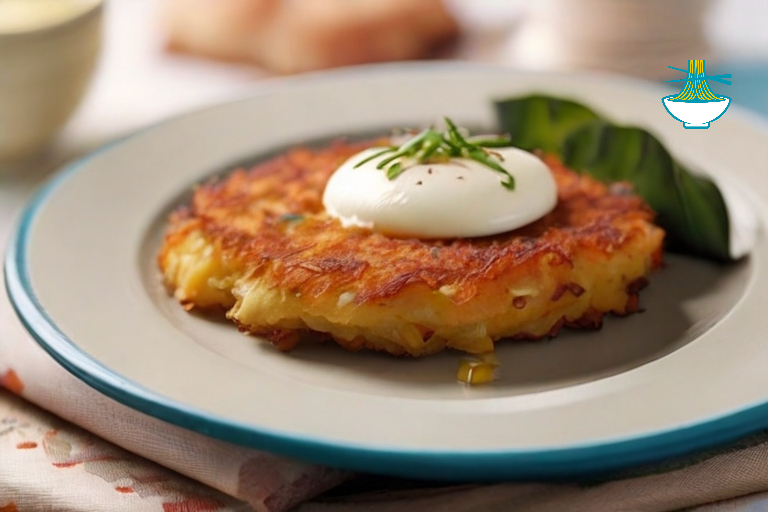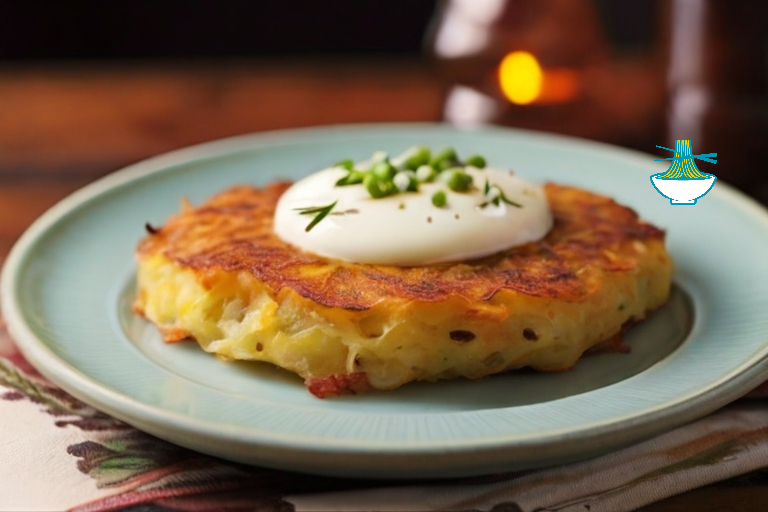Austrian Rösti is a delightful potato dish celebrated for its crispy golden-brown crust and tender interior, offering a perfect balance of texture and flavor. Originally a breakfast staple for Swiss farmers, this hearty dish found its way to Austrian cuisine, where it has become a beloved classic. Packed with essential nutrients like potassium, vitamin C, and dietary fiber from potatoes, Rösti provides energy and supports overall health. While its rich, crispy profile makes it irresistible, moderation is key to managing calorie intake. Often enhanced with onions, herbs, or cheese, Austrian Rösti is a versatile dish that embodies simplicity, tradition, and culinary excellence.

Ingredients:
- 4 large potatoes, peeled and grated
- 1 small onion, finely chopped
- 2 tablespoons butter
- 2 tablespoons vegetable oil
- Salt and pepper to taste
- Fresh parsley, chopped (optional, for garnish)
Instructions:
1- Grate the Potatoes: Using a box grater or a food processor, grate the peeled potatoes. Place the grated potatoes in a clean kitchen towel and squeeze out excess moisture.
2- Combine Ingredients: In a large mixing bowl, combine the grated potatoes with the finely chopped onion. Season the mixture with salt and pepper according to your taste.
3- Heat Butter and Oil: In a large skillet, heat the butter and vegetable oil over medium heat. The combination of butter and oil helps achieve a perfect balance of crispiness and flavor.
4- Form Rösti Patties: Take a handful of the potato mixture and form it into a flat, compact patty. Place the patty into the hot skillet, pressing it down with a spatula to ensure even cooking.
5- Cook Until Golden-Brown: Allow the Rösti to cook undisturbed for about 5-7 minutes or until the bottom is golden-brown and crispy. Carefully flip the Rösti using a spatula and cook the other side until it, too, is golden and crispy.
6- Repeat and Keep Warm: Repeat the process with the remaining potato mixture, adding more butter and oil to the skillet as needed. You can keep the cooked Rösti warm in the oven on a low setting while preparing the rest.
7- Garnish and Serve: Once all the Rösti patties are cooked to perfection, garnish with chopped fresh parsley if desired. Serve hot as a delightful side dish or even as a main course.
Enjoy your homemade Austrian Rösti – a delicious blend of crispy goodness and comforting flavors!
Frequently Asked Questions
1.Can Rösti Be Made Healthier?
- Yes, you can make Rösti healthier by using less butter and oil or opting for heart-healthy oils like olive oil. Baking instead of frying is another excellent way to reduce fat content.
2.What Is the Difference Between Austrian and Swiss Rösti?
- While both versions share a similar base of grated potatoes, Austrian Rösti often incorporates onions and other flavorings. Swiss Rösti tends to focus on a simpler preparation, sometimes using parboiled potatoes for a softer texture.
3.What Are the Best Potatoes for Rösti?
- High-starch potatoes, such as red or white potatoes, are ideal for Rösti as they yield a crispy texture and hold their shape well.
4.How Can Rösti Be Stored After Cooking?
- Store cooked Rösti in an airtight container in the refrigerator for 2-3 days. To reheat, use an oven at a low setting to restore its crispy texture.
5.Can Rösti Be Made Fully Vegan?
- Absolutely! Replace butter with plant-based oils and avoid using any dairy or non-vegan toppings.
6.What Are Healthy Alternatives to Butter and Oil?
- Olive oil and coconut oil are great alternatives, and using them in moderation helps maintain the flavor while reducing unhealthy fats.
7.Can Rösti Be Baked Instead of Fried?
- Yes, baking is a healthier alternative to frying. Spread the Rösti mixture on a parchment-lined baking tray, lightly coat with oil, and bake at 200°C (400°F) until golden and crispy.

Nutritional Values:
The nutritional values for the ingredients in the Austrian Rösti recipe can vary based on specific brands and quantities used. However, I can provide approximate values for the main components:
1. 4 Large Potatoes (about 800g):
- Calories: 680
- Carbohydrates: 156g
- Protein: 16g
- Fat: 1.6g
- Fiber: 16g
Benefit:Rich in carbohydrates, potatoes provide a good source of energy. They also contain dietary fiber, vitamins (such as vitamin C and B vitamins), and minerals like potassium,a mineral that helps regulate blood pressure and supports heart health. Potassium reduces the strain on blood vessels and balances the effects of sodium in the diet.
2. 1 Small Onion (about 100g):
- Calories: 40
- Carbohydrates: 10g
- Protein: 1g
- Fat: 0g
- Fiber: 2g
Benefit: Onions add flavor to the dish and are a good source of antioxidants. They contain vitamins C and B6, as well as dietary fiber. Onions also have potential anti-inflammatory and immune-boosting properties.
3. 2 Tablespoons Butter (about 28g):
- Calories: 200
- Carbohydrates: 0g
- Protein: 0.2g
- Fat: 22g
- Fiber: 0g
Benefit: Butter adds richness and flavor to the Rösti. It contains saturated fats and is a good source of vitamin A. However, moderation is key, as excessive saturated fat intake may have health implications.
4. 2 Tablespoons Vegetable Oil (about 28g):
- Calories: 240
- Carbohydrates: 0g
- Protein: 0g
- Fat: 28g
- Fiber: 0g
Benefit: Vegetable oil is a source of healthy fats, including monounsaturated and polyunsaturated fats. It provides energy and supports the absorption of fat-soluble vitamins. Choosing heart-healthy oils can contribute to overall well-being.
5. Salt and Pepper (amounts may vary, usually minimal):
- Negligible caloric contribution
Benefit: While used in moderation for flavor, salt is essential for maintaining electrolyte balance in the body. Pepper adds a pungent kick and contains antioxidants that may have anti-inflammatory properties.
6. Fresh Parsley (optional, for garnish):
- Negligible caloric contribution
Benefit: Parsley is a nutrient-dense herb, rich in vitamins A, C, and K. It also contains minerals like iron and folate. Parsley may contribute to improved digestion and has potential anti-inflammatory effects.
These values are rough estimates and can vary based on factors such as the size of the ingredients and specific product brands. Additionally, the cooking process may alter the nutritional content, especially with oil absorption during frying. It's always a good practice to refer to specific product labels for accurate information.


Comments